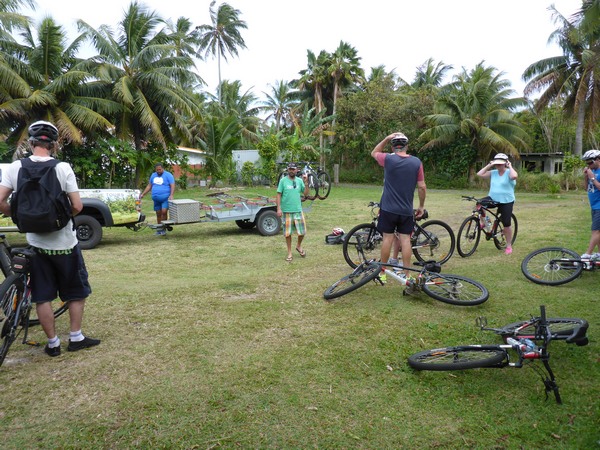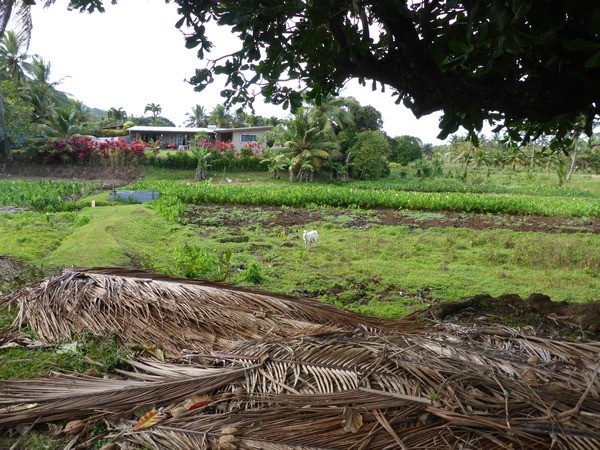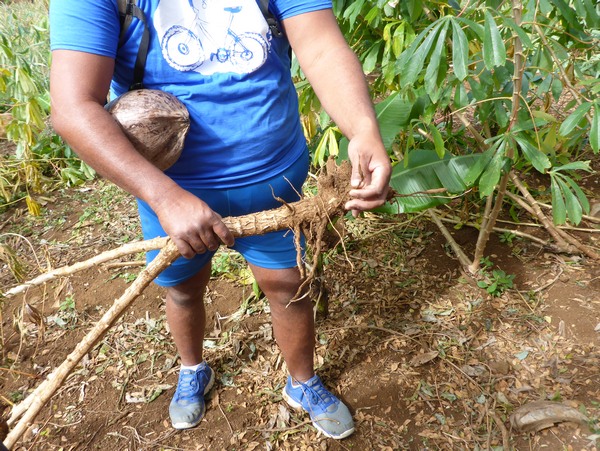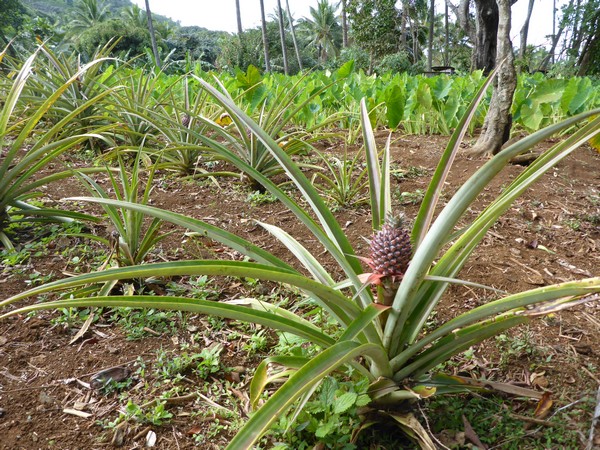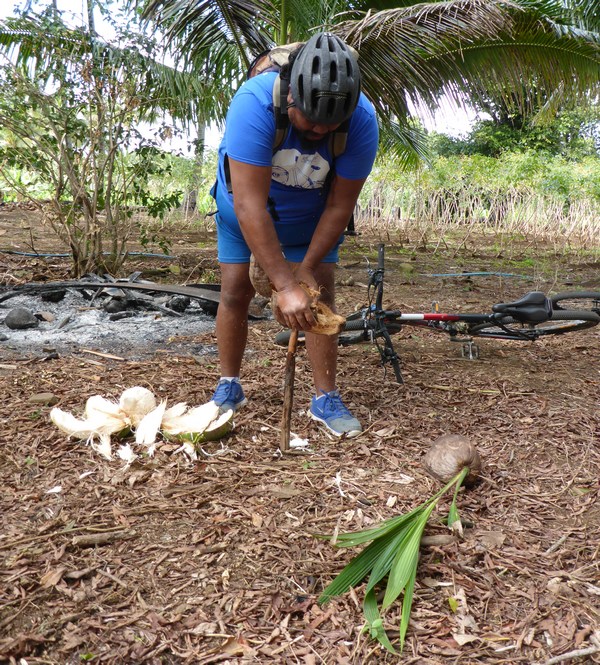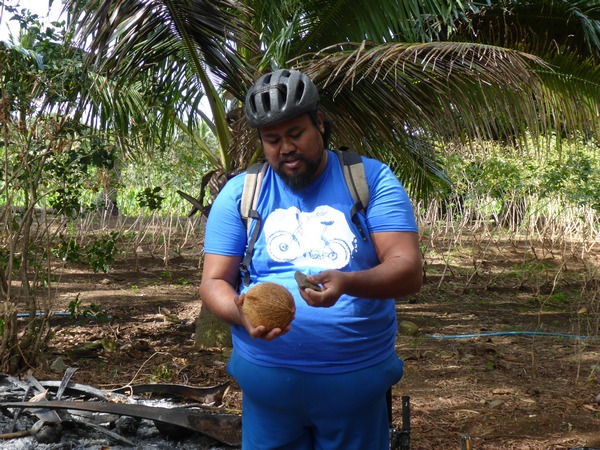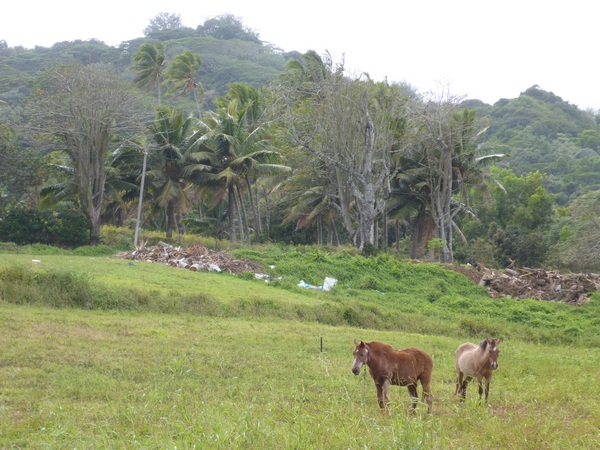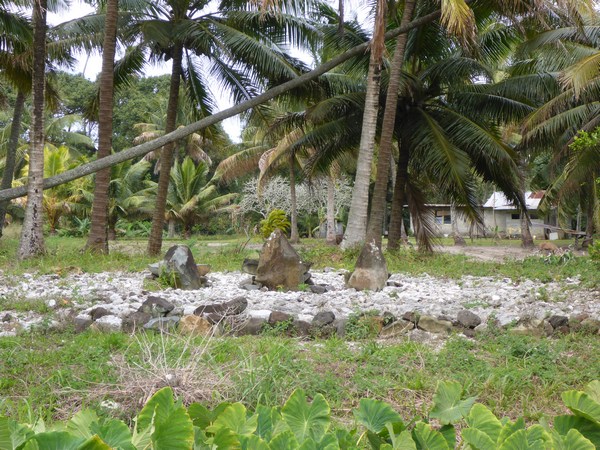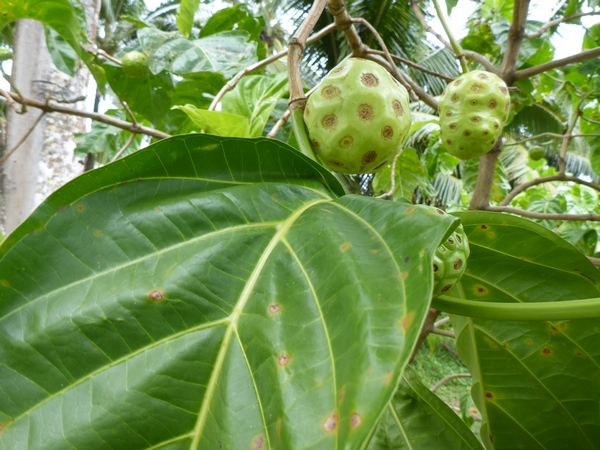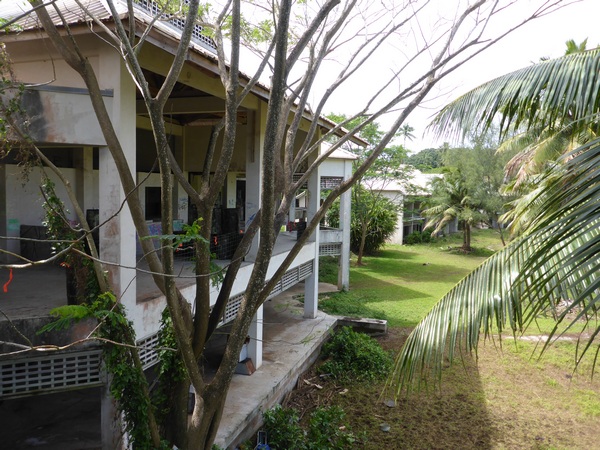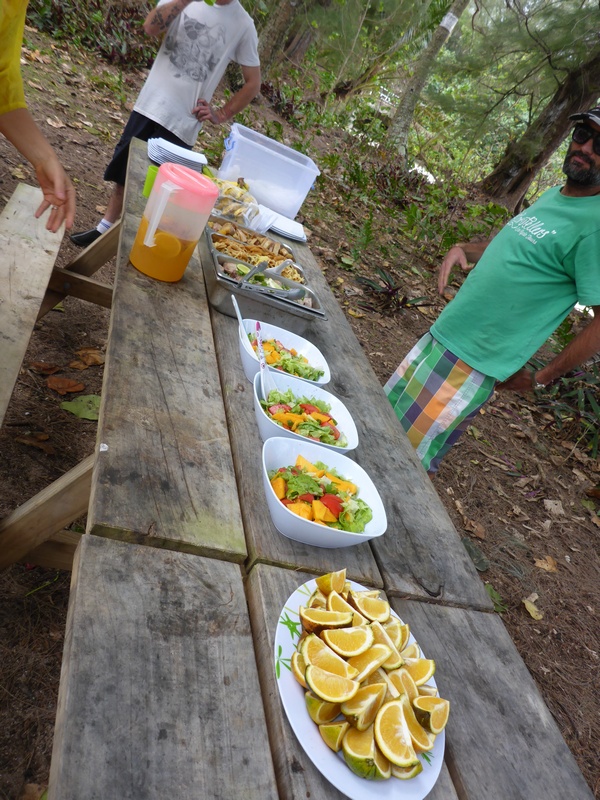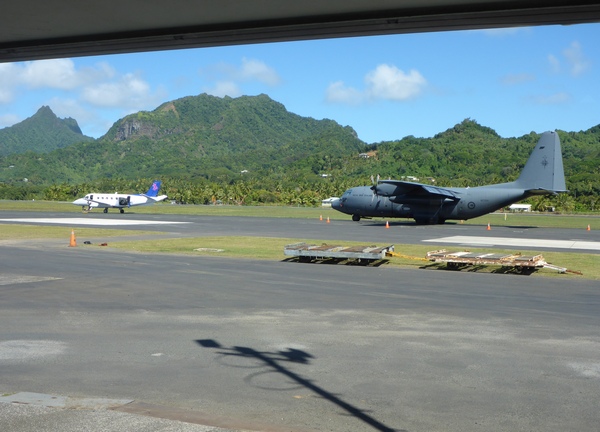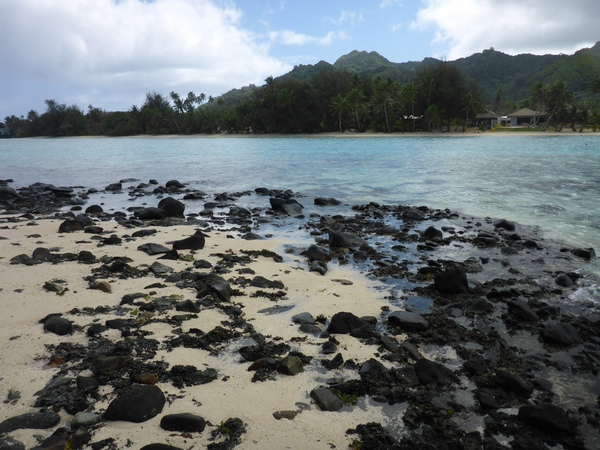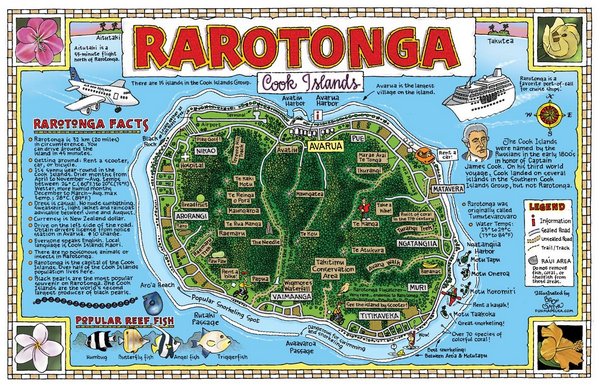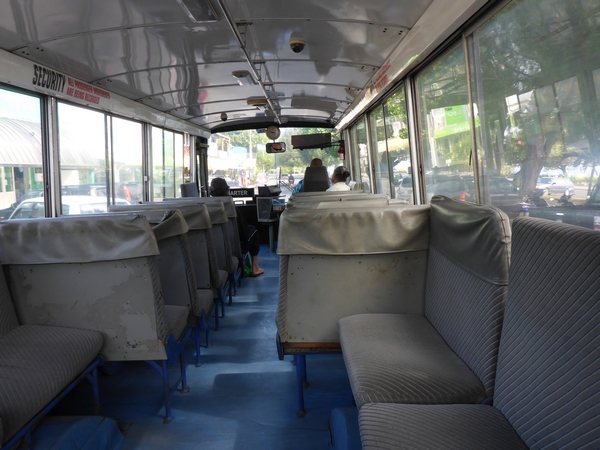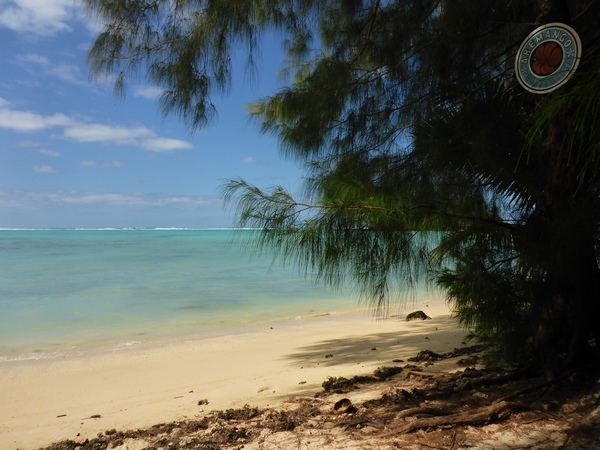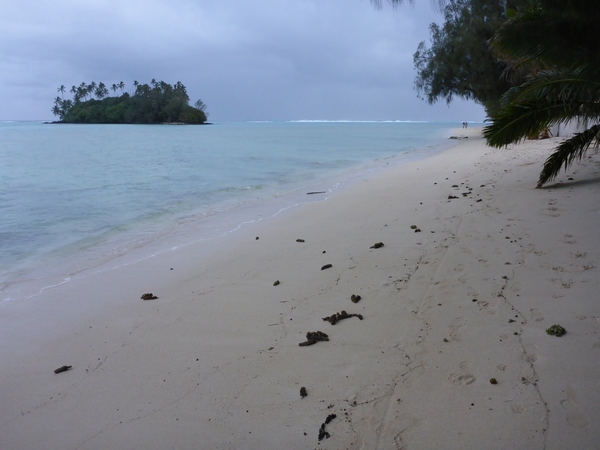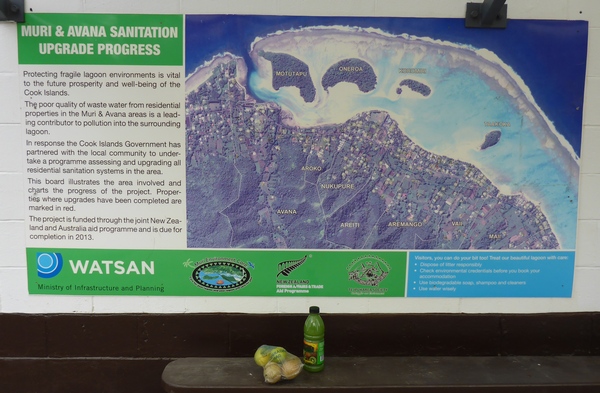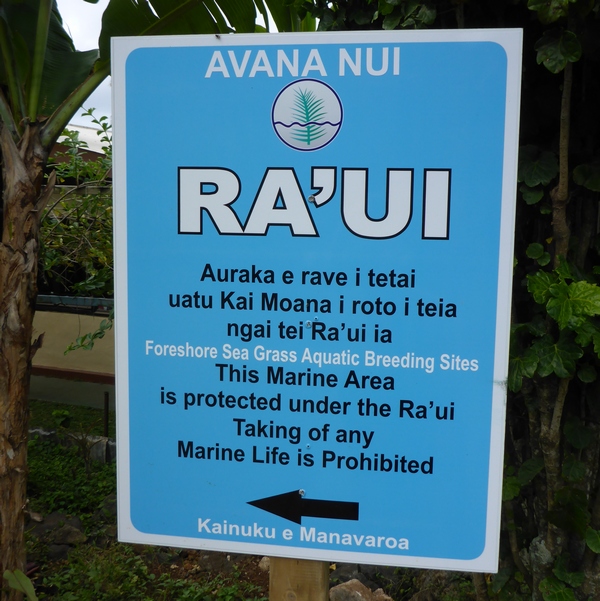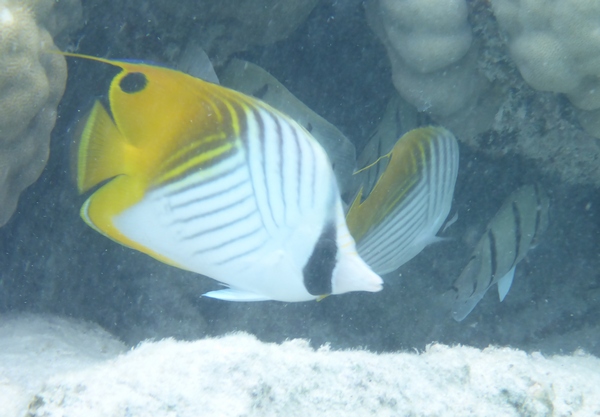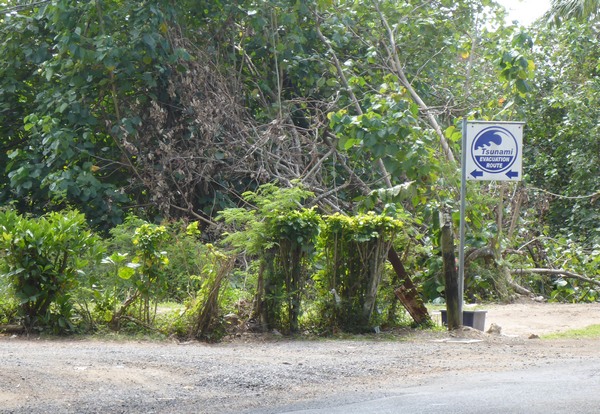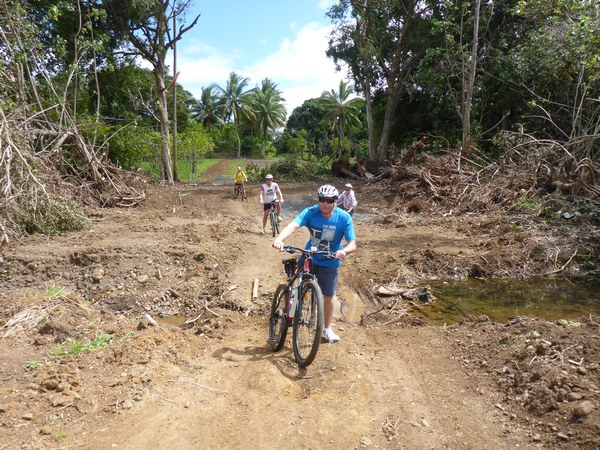There were very few activities or trips I booked in advance of arriving in the South Pacific, preferring to take advantage of opportunities when they presented themselves rather than being tied down to a schedule. The one exception was booking a place on a Storytellers Eco Cycle Tour on Rarotonga, for the morning after I arrived on the island. My logic for this was that (a) I like cycling, (b) it sounded like a good way to explore the island and get an introduction to Cook Islands culture and (c) when you’re travelling solo somewhere ten thousand miles away from home, it’s quite nice to have at least one planned thing to give you a bit of structure.
Getting up at seven a.m. bleary-eyed with jet lag was a bit painful, but several mugs of tea helped revive me (as did the morning chorus provided by Rarotonga’s several million chickens). I was picked up from Aremango Guesthouse by Dave from Storytellers, who cheerily ferried me and half a dozen other tourists staying at various points around the island to the start of our tour. There we were kitted out with helmets and sturdy bikes, before getting a safety talk and introduction from tour guides Natavia and Jimmy to our 4-hour cycle trip which would take in Rarotongan agriculture, traditional uses of plants, and some Cook Islands Maori history and culture.
Many Rarotongans still grow a lot of their own food (this is called ‘planting’ rather than ‘farming’). Growing plots have been cleared from the bush inland for planting vegetables and fruit, with the odd grazing animal such as goats and horses (and of course, chickens). Our first stop was by a taro patch: taro being a tropical plant in the Araceae family and one of the staple crops grown by Cook Islanders (it’s also used in Africa and southern India). Typically the starchy roots are boiled and used like potato; the leaves are also cooked with coconut milk to make the local dish called rukau.
Taro is a versatile crop, growing both in waterlogged swampy soils and in dry ones (although our local guide Jimmy explained that dry taro is not as tasty). A sackful of taro roots could be sold for NZ$100 – 120 and a good taro patch will yield 60 – 70 sackfuls. But cultivating taro is heavy work: first the soil in the taro patch must be dug over with a long-handled shovel, then a giant wooden ‘dibber’ (weighing 30 – 40 kg) is used to make holes for each individual taro plant. In a tropical climate weeds grow fast, so locals mulch their taro patches to prevent this. Formerly black polythene was used, but environmental concerns have led to people reverting to using biodegradable materials such as old cardboard with rito (coconut leaves) laid on top… Which looks far nicer than plastic.
Only locals can own land in the Cook Islands, and land is passed down within families. If a favourite son is getting married, a father will plant a taro patch for their wedding. Jimmy explained that many people do their own planting on Rarotonga but not everyone: if someone was to steal crops from another person’s taro patch it would not be regarded too severely, provided the thief was taking it for food and not to sell. He told us that if he spotted someone raiding his patch he would duck down out of sight so they didn’t realise that they had been seen… And then he would casually say to them a few days later, “Hey, how’d you like the taro?”
There is a general atmosphere of trust on Rarotonga and little crime, except for occasional opportunistic theft from tourists careless enough to leave valuables temptingly on display at the beach. Drink driving is also regarded more leniently than in other countries: police who stop drunk drivers will generally just confiscate their car or motorbike, telling them to walk home and retrieve their vehicle once they’ve sobered up. Recently however a local youth had died in a drink-driving accident, so there was a move towards trying to better educate people about the dangers of drink driving. I personally found cycling on the Ara Tapu pretty pleasant, as the vast majority of locals pootle along at an average speed of fifteen miles per hour… Very civilized.
The next staple crop we saw was cassava (aka maniota, arrowroot or tapioca). The advantage of cassava is that it is relative easy to propagate: you just chop the stem into short lengths and shove them into the soil. The disadvantage is that in its unprocessed raw state it contains cyanide, which makes you wonder who got the bright idea of eating it in the first place. To render cassava edible it has to be soaked for twenty-four hours and cooked. You can boil and then fry it to make tasty chips, or grate it and mix it with coconut cream and ripe bananas to make the yummy local dish known as poke.
As well as starchy root crops we saw plenty of fruit being grown as well, including pineapples. Natavia explained that two main varieties are grown on Rarotonga: the smooth-leaved pineapple and the spiky-leaved variety. The latter was introduced more recently and only produces for fruit for 2 – 3 years before you have to replant it; whereas the smooth-leaved pineapple is a perennial that keeps on producing for a longer period (and apparently yields sweeter-tasting fruits, too).
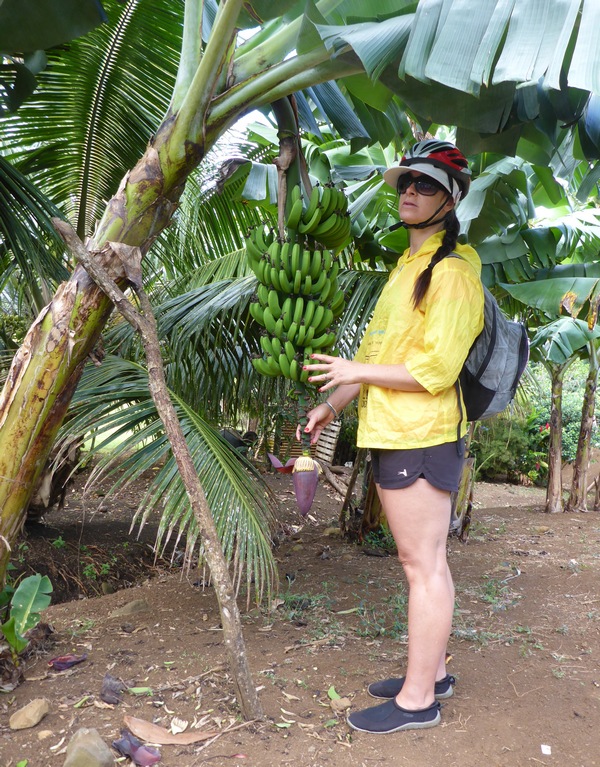 Bananas are another staple food here, usually grown on 3-stemmed plants. Natavia explained that once a few rows of bananas have started to form, the purplish-red flower is removed so that more energy will go into plumping up the fruits. As it was technically only early spring on Rarotonga, some of the banana plants still wore large plastic mesh bags covering their fruits and flowers, to shield them from low nighttime temperatures.
Bananas are another staple food here, usually grown on 3-stemmed plants. Natavia explained that once a few rows of bananas have started to form, the purplish-red flower is removed so that more energy will go into plumping up the fruits. As it was technically only early spring on Rarotonga, some of the banana plants still wore large plastic mesh bags covering their fruits and flowers, to shield them from low nighttime temperatures.
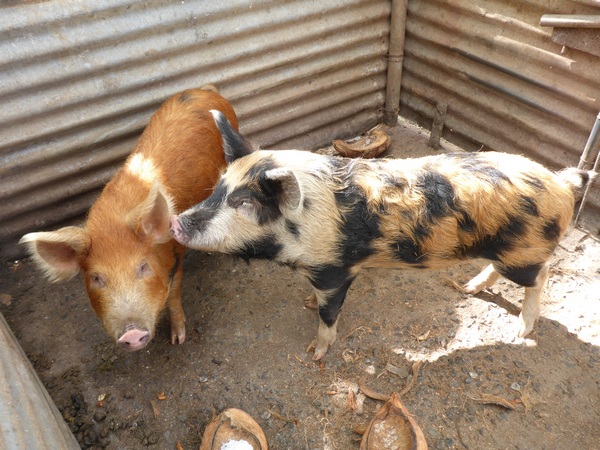 For the more carnivorous side of things, most households on Rarotonga keep a few pigs. These are typically kept penned or tied to a halter, so that they can’t wreak havoc on growing crops (a single pig can push over and destroy several banana plants in a single night, to get at the fruits and juicy water-filled stems). They are fed on coconut and usually end up being slow-baked in a traditional umu ground-oven, perhaps as part of a family celebration – or a meal for tourists!
For the more carnivorous side of things, most households on Rarotonga keep a few pigs. These are typically kept penned or tied to a halter, so that they can’t wreak havoc on growing crops (a single pig can push over and destroy several banana plants in a single night, to get at the fruits and juicy water-filled stems). They are fed on coconut and usually end up being slow-baked in a traditional umu ground-oven, perhaps as part of a family celebration – or a meal for tourists!
It’s not just the pigs who have coconut on the menu, though. Jimmy described it as the tree of life: a plant from which people can get most of their needs, including food, clothing, timber and roofing material. He showed us the three different stages of a coconut: the immature young nu or green coconut (which largely contains coconut water with a little jelly-like flesh); the mature akari coconut (the one we’re most familiar with, with its brown outer husk and solid layer of white inner flesh); and the sprouting uto coconut (where the creamy white interior has become mostly dry and fibrous, with a texture like marshmallow).
Jimmy demonstrated how to strip off the husk and open each of the three different coconut types, so we all got to try the different stages. I personally liked akari the best, maybe because that was what I’m most familiar with. The fresh sweet juice of nu was deliciously refreshing, but I couldn’t help thinking it would be even better with rum added to it. Nu are the coconuts which fetch the best price when sold locally to tourists. As a rule of thumb, if a coconut is lying on the ground it’s yours to eat: nobody gets possessive about the fruits because there are quite a lot of them about.
Coconuts are not just yummy and nourishing, the flesh can be grated and squeezed to make coconut cream (more of this in a later chapter). The oil is wonderful for treating burns, eczema and dry skin. Jimmy described how his relatives make monoi, a scented oil for use on hair and skin, by fermenting chopped coconut flesh with the leaves of the cinnamon tree. Monoi scented with different herbs and flowers is used across the South Pacific, and I can vouch for the fact that it’s wonderfully soothing.
After our introduction to coconuts we cycled onwards, following inland tracks that threaded between planting fields and the occasional grassy pasture where goats or horses grazed. Rarotonga’s volcanic origins mean that as soon as you head inland the terrain gets hilly. Jimmy explained that before European missionaries arrived in the Cook Islands, the majority of people lived up in the highlands, to be safe from possible raiding parties arriving by sea. The Christian missionaries somehow persuaded folks to descend from the heights, and now the lowland areas near the coast are where everyone makes their home.
We stopped to look at a Rarotongan marae, a hundred yards or so from the track. A marae is a meeting ground or sacred place, usually a rectangular cleared area of land (sometimes slightly raised), bordered by stones or wooden posts. Jimmy described how a marae is traditionally where a chief, tribal leader or elders pass judgements, settle disputes or have discussions to sort out tribal affairs. This marae had three stone seats: the central one for the tribal chief, the other two for the chief’s advisors. Marae must be treated with respect and no-one should set foot on one, unless invited by the appropriate tribal representative. In the past, women were not allowed onto marae at all, but this is one of the things that has changed over time: some tribes now have a woman chief. Marae used to be located high up in the hills, but most have been relocated to the lowlands so that local people don’t have to walk long distances when they need something resolved.
Our next stop was a grove of noni trees. Noni, which also goes by the charming names of Indian mulberry, cheese fruit or vomit fruit, is regarded as something of a panacea. It is claimed to have antioxidant, anti-ageing and even anti-cancer properties, although to date there are no scientific studies confirming this. Anecdotally, Natavia said she drank a small amount of noni juice (made by fermenting and pressing ripe fruits) every day, and has found that it cures sore throats and protects her from viruses. Jimmy also related how he had cured himself from a bad case of ciguatera (a thoroughly nasty and painful type of food poisoning caused by eating certain types of fish) by drinking a herbal cure made from noni leaves, so the plant evidently has some benefits.
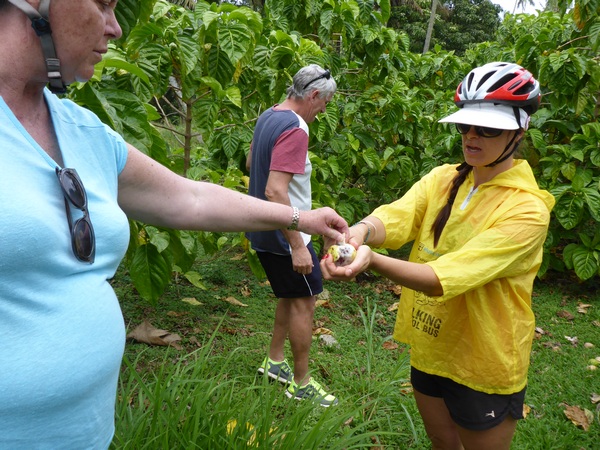 Natavia found some ripe fruits on the ground and split them open, inviting us to have a smell. It immediately became obvious how noni got some of its alternative monikers: the other tourists on our cycle trip recoiled with noises of disgust, while to my perhaps hardier nose the fruit had a strong smell of blue cheese. Drinking a glassful of noni juice every day suddenly seemed less appealing, despite its promised health benefits.
Natavia found some ripe fruits on the ground and split them open, inviting us to have a smell. It immediately became obvious how noni got some of its alternative monikers: the other tourists on our cycle trip recoiled with noises of disgust, while to my perhaps hardier nose the fruit had a strong smell of blue cheese. Drinking a glassful of noni juice every day suddenly seemed less appealing, despite its promised health benefits.
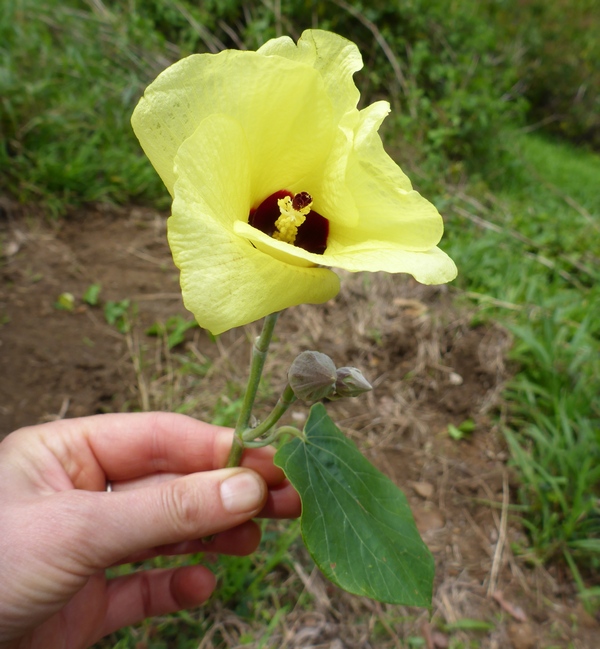 Cycling further into the bush, we next encountered some of the wild plants used locally for medicine and first aid. Yellow hibiscus or ‘au grows everywhere in the Cook Islands: its seeds can survive for months in salt water, colonising new islands, and the ‘au tree is hardy enough to grow even along sandy beaches.
Cycling further into the bush, we next encountered some of the wild plants used locally for medicine and first aid. Yellow hibiscus or ‘au grows everywhere in the Cook Islands: its seeds can survive for months in salt water, colonising new islands, and the ‘au tree is hardy enough to grow even along sandy beaches.
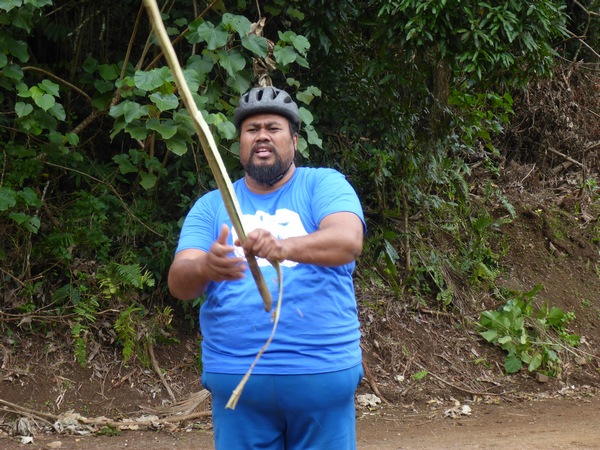 Jimmy demonstrated why locals never carry a first aid kit with them when planting or working in the bush: cutting a branch from an ‘au, he proceeded to peel it and then strip out the soft inner bark, to show how it could be used as a bandage. Scraping the peeled branch produced a juicy pith which he said was used to pack cuts and wounds, over which the inner bark strips would be wrapped and tied, the bark tightening as it dries to keep the wound clean and prevent infection.
Jimmy demonstrated why locals never carry a first aid kit with them when planting or working in the bush: cutting a branch from an ‘au, he proceeded to peel it and then strip out the soft inner bark, to show how it could be used as a bandage. Scraping the peeled branch produced a juicy pith which he said was used to pack cuts and wounds, over which the inner bark strips would be wrapped and tied, the bark tightening as it dries to keep the wound clean and prevent infection.
 Doctors at the local hospital are happy for people to use this natural remedy which is very efficacious… And it’s why all a local will take with them when working in the bush is a machete or knife for gathering the necessary plants.
Doctors at the local hospital are happy for people to use this natural remedy which is very efficacious… And it’s why all a local will take with them when working in the bush is a machete or knife for gathering the necessary plants.
Two more plants which can be useful are miri (or tree basil) and mile-a-minute vine (or American rope). Both of these are alien plant species, accidentally introduced and now ramping away to the detriment of native Cook Island plants and habitats.
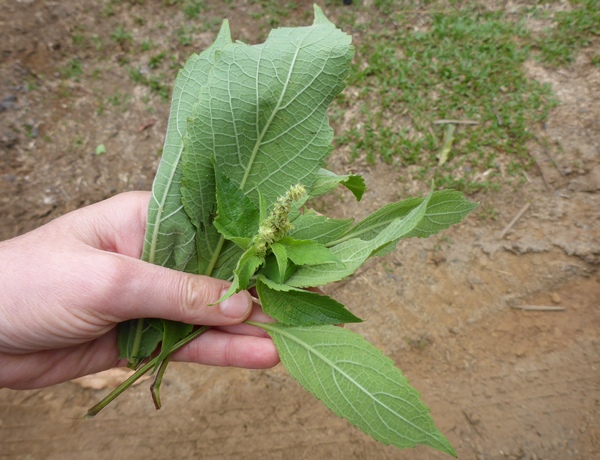 Miri comes in handy when there are mosquitoes about, which is pretty much all the time when you’re inland away from sea breezes. Simply scrunching up the leaves and rubbing the brownish juice on your skin makes an effective insect repellent, and one which I used more than once in my travels. A single leaf placed in a bottle of water flavours it nicely, too.
Miri comes in handy when there are mosquitoes about, which is pretty much all the time when you’re inland away from sea breezes. Simply scrunching up the leaves and rubbing the brownish juice on your skin makes an effective insect repellent, and one which I used more than once in my travels. A single leaf placed in a bottle of water flavours it nicely, too.
 Mile-a-minute vine as its name suggest grows prolifically: sometimes as much as nine centimetres a day. Like the ‘au, it is very good for healing cuts, wounds and sores: the leaves are scrunched up to make a pulp and then applied to cover the injury. Natavia related how she had sustained a nasty wound after a fall from her cycle, which she applied this magical herb to: not only did her injuries heal quickly, but with virtually no scarring.
Mile-a-minute vine as its name suggest grows prolifically: sometimes as much as nine centimetres a day. Like the ‘au, it is very good for healing cuts, wounds and sores: the leaves are scrunched up to make a pulp and then applied to cover the injury. Natavia related how she had sustained a nasty wound after a fall from her cycle, which she applied this magical herb to: not only did her injuries heal quickly, but with virtually no scarring.
The next leg of our cycle tour took us to the site of the notorious Hilton Rarotonga Resort Spa. This ghost hotel was originally launched as a project back in 1990, when the Cook Islands government teamed up with an Italian bank and the Sheraton hotel chain to build Rarotonga’s first 5-star luxury hotel development. Unfortunately much of the NZ$52 million loan needed to make it happen allegedly disappeared into the pockets of the Mafia and other dubious parties, resulting in the hotel project being abandoned after a few years, despite construction being 80% completed.
Various attempts have been made over the years to relaunch the project, most recently a bid by two New Zealand companies in 2014, but to date nothing has got off the ground. Some believe that this is because Vaimaanga, the site on which the hotel stands, is said to have a tapu upon it. In 1910 the land’s owner, More Uriatua, was shot dead during an argument with New Zealander William John Wigmore who leased some of the land for his copra plantation. More Uriatua’s daughter Metua placed a curse on the land, dooming any business upon it to failure. Wigmore’s copra plantation was the first to go under; followed by unsuccessful pineapple growing, a failed plant nursery, and a doomed citrus farm.
Vaimaanga does have an eerie feel to it. Some of the site’s fixtures and materials have been recycled by locals, and the crumbling buildings are now host only to paint balling and wildlife. It’s a great shame that the project has left the Cook Islands government with a mountainous debt and an unattractive derelict site, but as the original project included plans to blast channels through Rarotonga’s coral reef and build an exclusive private beach and marina on what is otherwise a totally free public access coastline, I personally felt inclined to side with Metua and let the land revert back to wilderness.
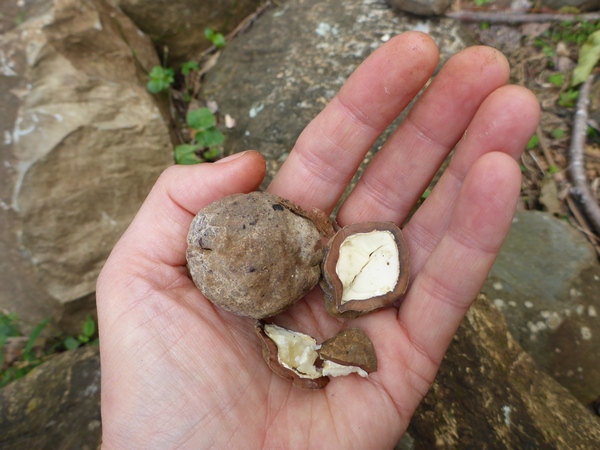 Coasting downhill from Vaimaanga led us past a large candlenut tree or tuitui. The large walnut-like fruits contain oil-rich nuts which were used, as the name suggests, as a source of light: several nuts would be threaded onto a thin spike and burned like small candles. Soot produced from burning candlenuts was also used in traditional tattooing methods. Like British conkers, candlenuts are high in saponins so should not be eaten raw… Unaware of this I sampled one. I don’t recommend you follow my example.
Coasting downhill from Vaimaanga led us past a large candlenut tree or tuitui. The large walnut-like fruits contain oil-rich nuts which were used, as the name suggests, as a source of light: several nuts would be threaded onto a thin spike and burned like small candles. Soot produced from burning candlenuts was also used in traditional tattooing methods. Like British conkers, candlenuts are high in saponins so should not be eaten raw… Unaware of this I sampled one. I don’t recommend you follow my example.
Luckily the lunch that was waiting for us at the end of our cycle ride was a lot tastier. Dave greeted us at a beachside picnic table spread with a proper feast: fresh tuna steaks, taro and cassava chips, macaroni cheese, salad with lettuce and tomato and pawpaw, and oranges and bananas for dessert. After four hours of off-road cycling I was ready to refuel, and tucked in with enthusiasm. It was the perfect end to a fascinating and entertaining morning: I would recommend the Storytellers cycle tour to anyone visiting Rarotonga, and Natavia and Jimmy and Dave are all lovely folks to boot.
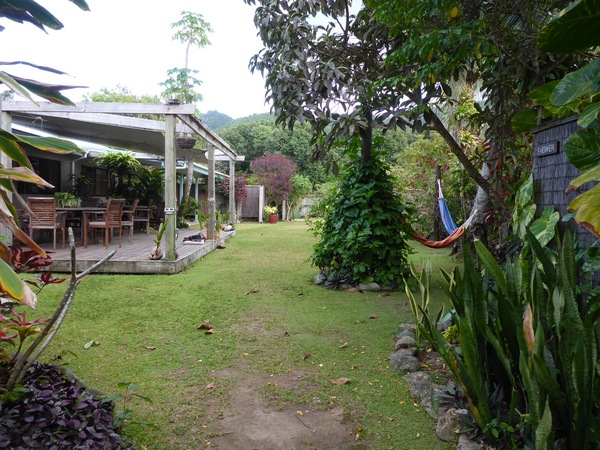 Back at Aremango Guesthouse I took a remedial stroll along the beach to help my enormous lunch go down, followed by a remedial nap in one of the hammocks in the garden to deal with the return of my let lag. After this I wrote up my travel journal, and mused upon the fact that I had only two more days’ stay on Rarotonga before heading northwards to the smaller islands of Aitutaki and ‘Atiu. Two days wasn’t long enough to do this friendly and diverse place justice, but it would have to do. Tomorrow I decided to explore on foot and do some snorkelling, feeling that it was high time I tested out my new mask and waterproof camera. As the mosquitoes began to rally their forces I retreated inside for supper and bed, leaving the tropical night to the cicadas, accompanied by the ever-present opera of chickens.
Back at Aremango Guesthouse I took a remedial stroll along the beach to help my enormous lunch go down, followed by a remedial nap in one of the hammocks in the garden to deal with the return of my let lag. After this I wrote up my travel journal, and mused upon the fact that I had only two more days’ stay on Rarotonga before heading northwards to the smaller islands of Aitutaki and ‘Atiu. Two days wasn’t long enough to do this friendly and diverse place justice, but it would have to do. Tomorrow I decided to explore on foot and do some snorkelling, feeling that it was high time I tested out my new mask and waterproof camera. As the mosquitoes began to rally their forces I retreated inside for supper and bed, leaving the tropical night to the cicadas, accompanied by the ever-present opera of chickens.
Coming up next time, in South Pacific Adventure part 3:
A desert island just the right size; undersea explorations; and getting scrubbed up for church on Sunday. I say goodbye to Rarotonga… and hello to Aitutaki.
…And if you’d like to read about my South Pacific travels from the beginning, go to the first chapter: Travels in the Cook Islands.

